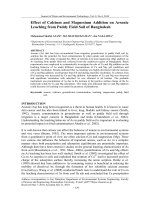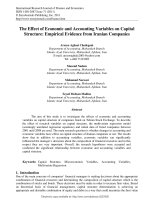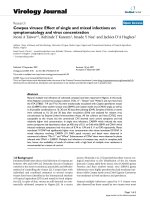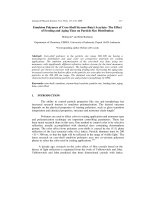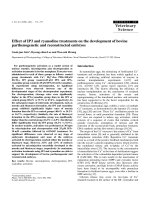Effect of genetic and non-genetic factors on first lactation production traits in Tharparkar cattle
Bạn đang xem bản rút gọn của tài liệu. Xem và tải ngay bản đầy đủ của tài liệu tại đây (158.81 KB, 5 trang )
Int.J.Curr.Microbiol.App.Sci (2019) 8(2): 2160-2164
International Journal of Current Microbiology and Applied Sciences
ISSN: 2319-7706 Volume 8 Number 02 (2019)
Journal homepage:
Original Research Article
/>
Effect of Genetic and Non-Genetic Factors on First Lactation Production
Traits in Tharparkar Cattle
Garima Choudhary*, U. Pannu, G.C. Gahlot and Sunita Meena
Department of Animal Genetics and Breeding, College of Veterinary and Animal Science,
Rajasthan University of Veterinary and Animal Sciences, Bikaner, Rajasthan, India
*Corresponding author
ABSTRACT
Keywords
Tharparkar,
Production traits,
Genetic factors,
Non-genetic factors
Article Info
Accepted:
18 January 2019
Available Online:
10S February 2019
The present study was conducted on 91 Tharparkar cows maintained at the Livestock
Research Station, Beechwal, Bikaner for 11 years i.e. from 2006 to 2016. The data were
analysed with the objective of performance appraisal of Tharparkar cattle with respect to
production traits and to study the effect of genetic factor i.e. sire group and non genetic
factors i.e. period and season of calving on production traits. The overall least-squares
means for first lactation milk yield (FLMY), first lactation length (FLL), first lactation dry
period (FDP), lactation milk yield per day of first lactation length (LMY/FLL) and
lactation milk yield per day of first calving interval (LMY/FCI) were found to be
1832.99±42.43 kg, 283.65±7.65 days, 148.14±6.05 days, 6.18±0.14 kg/day and 4.03±0.12
kg/day. The effect of sire was found to be significant on first lactation production traits.
The Period of calving had significant effect on FLL and LMY/FCI, while season of
calving had no significant effect on first lactation production traits. The AFC had
significant effect on FLMY and FLL.
Introduction
Livestock sector is the backbone of Indian
rural economy in terms of sustaining income
and employment. Due to tremendous
contribution of cattle to the Indian agriculture,
livelihood and food security, cow has
occupied a prime position in rural life of
India. Various indigenous breeds of cattle in
the country are the result of selection for
thousands
of
years,
evolution
and
development of the wild species in the
process of domestication to the local agro
climatic conditions. These breeds are now
losing ground due to intense competition from
other breeds and risk of economic viability
under the present system of management.
Tharparkar breed is adapted to the harsh
climatic conditions with extremes of
temperature, sand storms, recurrent famines
and xeric vegetation which are totally
unsuitable for dairy animals. In arid and semi
arid zones, Tharparkar cattle play an
important role in milk production and reared
in the drought prone region of northwest
2160
Int.J.Curr.Microbiol.App.Sci (2019) 8(2): 2160-2164
India,
especially
Jaisalmer,
Jodhpur
(Rajasthan) and Kutch region of Gujarat.
Since this breed has been used extensively for
crossbreeding in the past, only limited number
of purebred animals of this breed is available
at present in their home tract. In view of the
importance of the breed, efforts need to be
made for the conservation of Tharparkar
cattle. Various criteria of selection can be
used to bring about genetic improvement in
overall performance of Tharparkar cattle. For
formulating breeding programmes for dairy
cattle it is essential to evaluate the
performance in terms of various production
traits which are of economic importance.
Knowledge of genetic and non genetic factors
influencing performance traits is also
important for the success of any breeding
programme.
Materials and Methods
The data for the present investigation were
obtained from the records of Tharparkar
cattle, located at the Livestock Research
Station, Beechwal, Bikaner. Records of the 91
cows which calved during the year 2006 to
2016 were included in the study. Some
animals were shifted from Livestock Research
Station, Chandan, Jaisalmer to Livestock
Research Station, Beechwal, Bikaner in the
year 2011 along with their records. Records
of these animals were also included in the
study.
The production traits studied were first
lactation milk yield (FLMY), first lactation
length (FLL), first dry period (FDP), lactation
milk yield per day of first lactation length
(LMY/FLL), lactation milk yield per day of
first calving interval (LMY/FCI). The entire
duration from year 2006 to 2016 was divided
into four periods viz. P1 (2006 - 2008), P2
(2009 - 2010) P3 (2011-2013), P4 (20142016). Each year divided into three seasons
viz. summer S1 (March to June), monsoon S2
(July to October) and winter S3 (November to
February). The analysis was carried out using
least-squares and maximum likelihood
computer program of Harvey (1990) with the
following mixed model:
Yijkl= µ + Si + Aj + Bk + b ( Xijkl - X̅ ) + eijkl
Where, Yijkl= observation on the lth cow of ith
sire, born in jth period and kth season, µ =
Overall population mean, Si = random effect
of ithsire,Aj= fixed effect of jth period of
calving,Bk = fixed effect of kth season of
calving, b = The regression of variable on age
at first calving, Xijkl = age at first calving
corresponding to Yijkl, X̅ = average age at first
calving, eijkl= Random error NID( 0,σ2 ).
Results and Discussion
The least squares means of first lactation
production traits are presented in Table 1. The
least-squares mean for first lactation milk
yield was observed to be 1832.99 ± 42.43 kg
in present investigation. Similar findings were
reported by Rahumathulla et al., (1994) and
Hussain et al., (2015) in Tharparkar cows.
The effect of period of calving on FLMY was
found to be non- significant. Doharey (2012)
in Hariana cattle also reported similar results.
Effect of season of calving did not exhibit
significant effect on FLMY. The present
results are in line with the results ofHussain et
al., (2015) in Tharparkar, Dahiya (2002) and
Doharey (2012) in Hariana cattle. This might
be due to adaptability of animals to local
climatic conditions. The effect of sire on first
lactation milk yield in Tharparkar cows was
observed to be significant. Similar findings
were also reported by Dahiya (2002) and
Doharey (2012) in Hariana cattle. The results
suggested that sire is a significant source of
causing variability in the first lactation milk
yield. The significant effect of sire indicated
that sire selection for this trait can bring
further genetic improvement in the herd.
2161
Int.J.Curr.Microbiol.App.Sci (2019) 8(2): 2160-2164
Table.1 Least-squares mean ± SE for FDP, FLL, FLMY, LMY/FLL and LMY/FCI
Traits
Over all
mean
Sire
Period
P1
(2006 2008)
P2
(2009 2010)
P3
(20112013)
P4
(20142016)
Season
S1
(Summer)
S2
(monsoon)
S3
(winter)
Regression
on AFC
Regression
coefficient
FLMY
1832.99±42.43
(91)
*
NS
1842.83±163.44
(18)
FLL
283.65±7.65
(91)
**
*
297.91±28.09a
(18)
FDP
148.14±6.05
(83)
*
NS
109.84±23.42
(16)
LMY/FLL
6.18±0.14(91)
*
NS
6.04±0.47
(18)
LMY/FCI
4.03±0.12
(83)
*
*
4.43±0.40ab
(16)
1618.34±155.95
(15)
239.57± 27.16b
(15)
148.37±24.08
(9)
6.49±0.44
(15)
3.81±0.42bc
(9)
1864.13±139.19
(28)
278.10±25.11a
(28)
153.07±18.31
(28)
6.33±0.39
(28)
4.60±0.29a
(28)
1880.84±145.14
(30)
299.13±25.83a
(30)
171.54±21.72
(30)
6.03±0.41
(30)
3.33±0.36c
(30)
NS
1806.44±132.79
(40)
1778.96±195.09
(9)
1819.20±131.36
(42)
*
NS
282.20±24.34
(40)
275.57±32.17
(9)
278.26±24.18
(42)
**
NS
149.43±18.59
(34)
152.37±26.60
(9)
135.32±17.53
(40)
NS
NS
6.16±0.37
(40)
6.29±0.57
(9)
6.22±0.36
(42)
NS
NS
3.99±0.29
(34)
4.02±0.47
(9)
4.11±0.27
(40)
NS
0.4444±0.2218
0.1104±0.0326 0.0413±0.0345 -0.0009±0.0007 -0.0005±0.0007
(** - Highly significant (P≤ 0.01); * - Significant (P≤0.05); NS - Non-significant)
The least-squares analysis of variance of data
revealed that regression of first lactation milk
yield on age at first calving was significant (P
≤ 0.05) and positive. The least squares
estimate of first lactation length was 283.65 ±
7.65 days in the present study. It is almost
similar to the estimates reported by
Panneerselvon
et
al.,
(1990)
and
Rahumathulla et al., (1994) in Tharparkar
cattle. The analysis of variance (Table 1)
revealed that the effect of period of calving
was significant (P ≤ 0.05) for first lactation
length. Gahlot(1999) and Hussain et al.,
(2015) in Tharparkar cattle also observed
significant effect of period of calving on FLL.
The significant difference in FLL is probably
due to different fodder availability and
different managemental conditions in
different periods. Effect of season of calving
did not exhibit significant effect on first
lactation length. The present results are in line
with the results of Gahlot (1999) in
Tharparkar and Doharey (2012) in Hariana
cattle. The results of this study revealed that
the effect of sire on FLL in Tharparkar cows
was observed to be highly significant. Similar
findings were also reported by Singh (2015)
in Sahiwal cattle. The regression of FLL on
2162
Int.J.Curr.Microbiol.App.Sci (2019) 8(2): 2160-2164
AFC was found to be highly significant (P ≤
0.01) in present study.
The first dry period of Tharparkar cows was
observed to be 148.14 ± 6.05 days in the
present investigation. It is almost similar to
the estimates reported by Swami et al.,(2005)
in Hariana cattle and Singh et al., (2005) in
Sahiwal cattle. The result of present study
revealed that the period of calving had nonsignificant influence on first dry period.
Doharey (2012) in Hariana breed of cattle
also reported non-significant effect of period
of calving on first dry period. Effect of season
of calving had non-significant influence on
FDP. The present results are in line with the
results ofNehra (2004) in Rathi, Singh (2015)
in Sahiwal, Doharey (2012) in Hariana and
Hussain et al., (2015) in Tharparkar cattle.
The results of this study revealed that the
effect of sire on first dry period in Tharparkar
cows was observed to be significant. Similar
findings were also reported by Doharey
(2012) in Hariana cattle and Singh (2015) in
Sahiwal cattle. Regression of AFC on first dry
period was found to be non-significant in
present study.
The least-squares mean of lactation milk yield
per day of first lactation length was estimated
as 6.18 ± 0.14 kg/day. Almost similar
findings were reported by Gahlot (1999) as
6.15 ± 0.10 kg/day in Tharparkar cattle. The
effect of period of calving and season of
calving on lactation milk yield per day of first
lactation length was found to be nonsignificant in present investigation. This study
revealed that the effect of sire on lactation
milk yield per day of first lactation length in
Tharparkar cows was observed to be
significant. Regression of AFC on LMY/FLL
was found to be non-significant in present
study.
The least-squares mean of lactation milk yield
per day of first calving interval was estimated
as 4.03 ± 0.12 kg/day. The analysis of
variance (Table 1) revealed that the effect of
period of calving was significant (P ≤ 0.05)
for lactation milk yield per day of first calving
interval. Effect of season of calving did not
exhibit significant effect on lactation milk
yield per day of first calving interval. The
results of this study revealed that the effect of
sire on lactation milk yield per day of first
calving interval in Tharparkar cows was
observed to be significant. The least-squares
analysis of variance of data revealed that
regression of LMY/FCI on AFC was nonsignificant.
In conclusion, the least squares means for
FLMY, FLL, FDP, LMY/FLL and LMY/FCI
were found to be1832.99±42.43 kg,
283.65±7.65 days, 148.14±6.05 days,
6.18±0.14 kg/day and 4.03±0.12 kg/day. The
effect of seasonof calving was found nonsignificant whereas, the effectof period of
calving was found to be significant on FLL
and LMY/FCI. The significant difference in
FLL and LMY/FCI in different periods was
probably due to climatic changes and
availability of feed across the different
periods and managemental conditions
practiced in particular period. Significant
effect of sire on all the first lactation
reproduction traits under study indicated that
sire selection can bring further genetic
improvement in the Tharparkarherd for these
traits.
References
Dahiya, D.S. (2002). Relative efficiency of
sire evaluation procedures for milk
production incorporating auxiliary traits
in Hariana cattle. Ph.D. Thesis, CCS
HAU, Hisar.
Doharey,
M.
(2012). Evaluation
and
Projection of lifetime performance traits
in
Hariana cattle. Ph.D. Thesis,
LUVAS, Hisar.
2163
Int.J.Curr.Microbiol.App.Sci (2019) 8(2): 2160-2164
Gahlot, G.C. (1999). Genetic evaluation of
Tharparkar cattle. Ph.D. Thesis.
Rajasthan
Agriculture
University,
Bikaner.
Harvey, H.R. (1990). User’s guide for
LSMLMW PC –Ι Version mixed model
Least
Squares
and
Maximum
Likelihood
computer
programme.
LOWA state university, USA.
Hussain, A., Gupta, A.K., Dash, S.K., Manoj,
M. and Ahmad, S. (2015). Effect of non
genetic factors on first lactation
production and reproduction traits in
Tharparkar cattle. Indian J. Anim.
Res., 49(4): 438-441.
Nehra, K.S. (2004). Prediction of sire
breeding values for economic traits in
Rathi cattle.Ph.D. Thesis, Rajasthan
Agriculture University, Bikaner.
Panneerselvon, S., Natarian, N., Thangara,
J.P., Iyue, M.L. and Rahumathula, P.S.
(1990). Genetic studies on productive
and reproductive traits in Tharparkar
cattle. Cheiron19: 1-6.
Rahumathulla, P.S., Natrajan, N., Edwin,
M.J., Silvaselvam, S., Subramanian, A.
and Khan, M.M.H. (1994).Studies on
first lactation traits in Jersey x
Tharparkar cows. Cheiron, 23: 1-8.
Singh, J. (2015). Genetic studies on first
lactation and life time traits and sire
evaluation using animal models in
Sahiwal
cattle,
Ph.D.
Thesis, GBPUAT,Pantnagar.
Singh, V.K., Singh, C.V., Kumar, D. and
Kumar, A. (2005).Genetic evaluation of
some economic traits in Sahiwal and its
crossbreds. Indian J. Dairy Sci., 58(3):
206-210.
Swami, P.D., Vijay Kumar, Murdia, C.K,
Barhat, N.K., Joshi, R.K. and Kumar, P.
(2005). Effect of non-genetic factors on
production traits in Hariana cattle.
Indian J. Dairy Sci.58: 299-301.
How to cite this article:
Garima Choudhary, U. Pannu, G.C. Gahlot and Sunita Meena. 2019. Effect of Genetic and
Non-Genetic Factors on First Lactation Production Traits in Tharparkar Cattle.
Int.J.Curr.Microbiol.App.Sci. 8(02): 2160-2164. doi: />
2164
